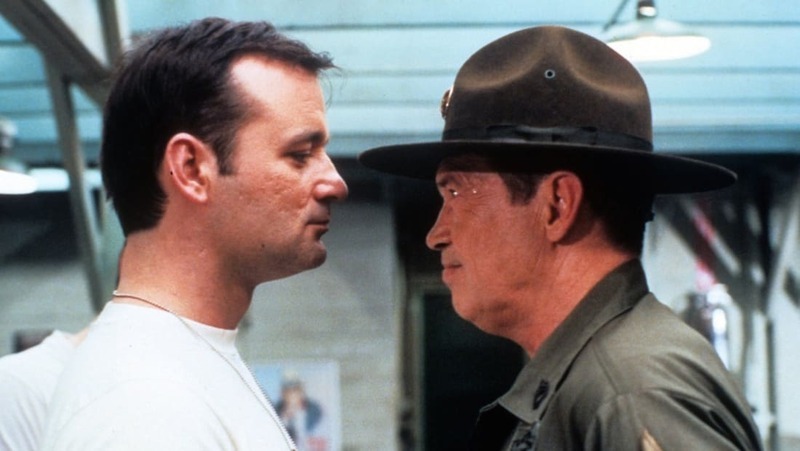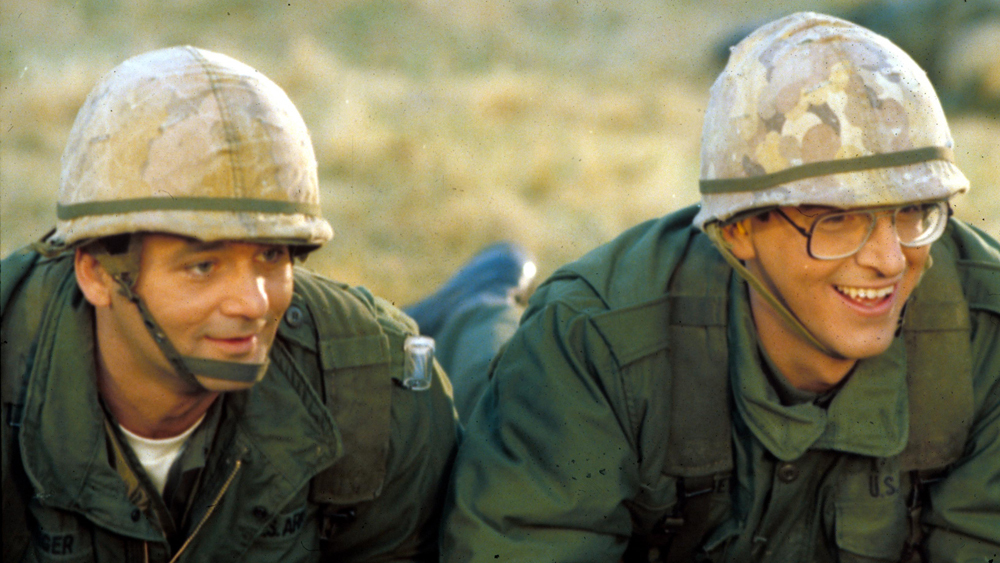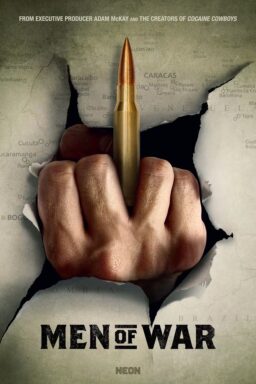In 1975, when “Saturday Night Live” debuted on NBC, the cast was referred to as the “Not Ready for Prime-Time Players.” The label was a bit misleading. Comprised of performers from both the National Lampoon and Second City comedy troupes, it would have been inconceivable five years earlier to have produced a sketch comedy show for one of the major three networks starring a bunch of comedic anarchists. But with the debut of “All in the Family,” the fallout of Watergate, and the end of the Vietnam War, the times they were a-changin’. The counterculture was now becoming a consumerist culture, and the premiere of “Saturday Night Live” signaled a long reconciliation between the Baby Boomers and the Greatest Generation. The generation gap that had been so wide a decade earlier was closing.
Early breakout stars from “Saturday Night Live” include Chevy Chase, a whip-smart mimic who quickly left the show for Hollywood. Chase would find his biggest movie success with the National Lampoon-endorsed “Vacation” franchise. And John Belushi, the combustible wild man of “SNL,” gave his most memorable performance in the John Landis-directed “National Lampoon’s Animal House” (1978). “Animal House” became a cultural touchstone for the way it brought the fringe world of fraternities into the mainstream. But the one performer from “Saturday Night Live” who best epitomizes both the anti-Establishment ethos of the counterculture and ushered in the cool, detached irony of the next generation was Bill Murray. And the one movie that could rival “Animal House” for its lasting cultural influence is the anarchic service comedy “Stripes.”
Released in 1981, six months after Ronald Reagan’s inauguration, “Stripes” was sold to the studio as “Animal House Joins the Army.” (Actually, it was originally conceived as a vehicle for Cheech & Chong.) The movie exemplifies how the counterculture went mainstream, defanging itself for fame and fortune, and happily joining the establishment it once lived to tear down. Recounting the adventures of a bunch of smart-alecky, thirtysomething post-hippie types who find a sense of purpose by enlisting in the US Army, “Stripes” now plays like a poker-faced endorsement of a sentiment that climaxed 1960s at dinner-table arguments between long-haired, pot-smoking, Establishment-mocking sons and their World War II generation fathers.

While not an official entry in the National Lampoon franchise, there is enough talent involved that it more or less qualifies as a stealth addition to the canon. Director Ivan Reitman was a co-producer on “Animal House” and directed Murray in his first movie “Meatballs” (1979). Co-star and co-screenwriter Harold Ramis co-wrote “Animal House” and made his directorial debut with “Caddyshack.” Second City alums John Candy and Joe Flaherty have key supporting roles. But at the center of it all is Bill Murray, acting as a kind of detached Zen master of comedy, a character who was inside and outside the story at the same time.
Surprisingly big and with a seemingly permanent smirk on his face, Bill Murray was never a conventional film star. He looks as if he could play heavies or hulking dim-witted sidekicks. But on “Saturday Night Live,” he made it a point not to play “characters.” Instead, no matter what the sketch started out as, the moment Murray appeared you knew it was going to go off into a completely different direction.
Murray was a more accessible Andy Kaufman, the “SNL” guest performer who seemed to revel in making audiences find the joke. Like Kaufman, Murray let you in on the fact that you were watching a live show. He let you in on the joke of show business, but Murray wasn’t as alienating. He was charming. Unlike, say, Steve Martin’s absurdist-deconstructionist style of comedy, Murray’s too-cool-for-school approach is what made him so appealing to both aging middle-class Boomers who were nostalgic for their raising-hell youth and their always-questioning Gen-X kids.
This was evident with the surprise success of “Meatballs,” a quickie cheap Canadian production designed to showcase Murray. Released during the summer of 1979, “Meatballs” was the sleeper hit that more than held its own against such major releases as “Alien,” “Rocky II,” and “Escape from Alcatraz.” The movie was thin on character and plot, little more than a series of loosely strung together gags involving hot-dog eating contests and relay races, with Murray as the coolest camp counselor ever. That’s why young people kept returning to the movie all summer. The following year brought “Caddyshack,” a raucous underdog sports comedy set in the laid-back world of golf. The movie was sold as a Chevy Chase vehicle, but it was the scene-stealing supporting performances by Rodney Dangerfield (as a wealthy, cheerfully vulgar club member) and Bill Murray that made it memorable. As Carl Spackler, the dedicated groundskeeper doing battle with a gopher, Murray gives a masterful performance in minimalist physical comedy. Carl’s slapstick war against a rodent became a movie-within-the-movie, a stoner comedy minus the drugs, with Murray’s mystical focus anchoring the ridiculousness. Murray emerged as the de facto star of “Caddyshack,” and by the time “Stripes” made his leading man status official one year later, his first-billed name on the poster felt like a formality—or a coronation.

What makes this set-up different is the way the movie views the character of John Winger. In the late ‘60s or early ‘70s, John was seen as a free-spirit, the kind of character Jack Nicholson portrayed in movies like “Easy Rider” (1969) and “Five Easy Pieces” (1970), or Bud Cort played in “Brewster McCloud.” Audiences would have identified completely with his desire not to be tied down. The questioning of authority would be seen as a righteous cause. Even if the character failed, he failed for the right reason. Now, a character like that is viewed as having a “problem.” We are always on the side of Murray as the insubordinate wiseass, but we are also made to feel that what’s missing from his life is discipline. Like Judy Benjamin in the previous year’s “Private Benjamin,” Winger needs to learn the value of “respect,” and a comically hard-ass father-figure drill instructor is just the person to teach him. “Stripes” follows the trajectory of a traditional service comedy. But Bill Murray is the wild card. For a while he lets us know he’s in a service comedy.
“Stripes” was released six months after the inauguration of Ronald Reagan, and that’s not an insignificant detail. A creature of Hollywood, Reagan brought glitz and glamour to Washington. Reagan understood the power of images and that the surface could be the substance. Hollywood did its part by propping up this myth. Reagan’s brand of flag-waving military might was reflected in the movies. As the ‘80s roared on, critics started to clutch their pearls over an escalating series of jingoistic action movies. Movies like “Red Dawn” (1984), “Rambo: First Blood Part II” (1985), “Rocky IV” (1985), “Iron Eagle” (1986), and “Top Gun” (1986) were seen as part of Hollywood’s wave of New Patriotism. They were movies as recruitment posters. The truth is a little more complicated. The co-dependent relationship between Washington and Hollywood has existed almost from the moment Hollywood was founded. Movies as varied as “Wings” (1927), “The Best Years of Our Lives” (1946), and “Pork Chop Hill” (1959) wore their pro-soldier, pro-America humanism on their lapels. Even as the Vietnam war was raging, John Wayne was able to get made “The Green Berets” (1968).
But the war movies of the 1980s were different in that they were devoid of political context or content. (This is the lasting legacy of Reagan.) War movies from previous eras used specific conflicts as a backdrop. Since America always came out as a victor it didn’t really matter which conflict was being depicted. That changed with Vietnam. Robert Altman’s counterculture service comedy “M*A*S*H” used the Korean War as a thinly veiled stand-in for Vietnam to tell its story of hippie surgeons sticking it to the generals. “M*A*S*H” was unique among all the Vietnam movies because the hippie surgeons played by Donald Sutherland and Elliott Gould were defiant in their unwillingness to bend to the will of the military brass. That’s what made them true patriots. Later, after the war was over, we got a series of movies that had Vietnam as its backdrop but not its subject matter. Movies like “Coming Home” (1978) and “The Deer Hunter” (1978) dealt with the trauma and fallout of the war and honoring the experiences of the soldiers who fought in it. Even “Apocalypse Now” (1979) used the Vietnam war and Joseph Conrad’s “Heart of Darkness” as a way to meditate on the nature of (all-caps) WAR. But the war movies of the 1980s were different. They were stripped of political content in every way except for one: they were all about re-staging Vietnam with a victorious outcome. And that begins with “Stripes.”

Some of the secondary characters are vivid comic caricatures, like John Candy as Winger’s sidekick, who’s lovable but ferociously aggressive, and John Larroquette as a weaselly captain. But there’s less subversion here than you might think. As drill instructor Sgt. Hulka, Warren Oates acts as if he’s in a serious war movie, which makes the character funnier but also presages the absolutely-not-joking drill sergeant played by Louis Gossett, Jr. in “An Officer and a Gentleman” the following year, who helps a rebellious young man from an abusive background (Richard Gere) find dignity and purpose through military life. There’s a similar dynamic happening in the score for “Stripes.” It’s by Elmer Bernstein, who was typecast doing adventure film scores in the 1960s and found a new niche in the ‘80s with “Animal House” doing basically the same scores, but for comedies. The music is as stirring as his work for “The Magnificent Seven” and “The Great Escape,” but more smiley-faced. The cinematography by Bill Butler (“The Conversation,” “Jaws,” “Sniper”) has a vivid richness appropriate for straight war/adventure movies. Early on, there’s a beautiful backlit shot at sunset as the cadets unironically sing a recruitment jingle while traversing an obstacle course.
The movie’s dramatic highpoint comes when Winger and Sgt. Hulka have a private showdown and the movie transitions from irreverent to something more traditional. The scene is played straight as the movie calls out Murray’s emotional detachment, re-framing it as something he needs to get past if he’s going to become something other than a failure. This leads to an iconic scene where the platoon performs a hip yet syncopated marching-band-like routine at graduation, masterminded by Winger. Winger is still a wiseass, but Murray now plays him as somebody who has seen the light and decided to buy into a narrative he used to sneer at. His rebel facade is as thin as a T-shirt.
When Winger is rallying the platoon into straightening out, he says, “We’ve been kicking ass and taking names for two hundred years! We’re ten-and-one!” That “ten-and-one” line is the kind of joke you’d find in the pages of National Lampoon. It’s the only moment in “Stripes” that could be considered political commentary. But the line is not about one loss. It’s about ten wins. By the end of “Stripes,” Winger has become a bonafide soldier. The climax is a rescue mission into USSR-occupied Czechoslovakia that makes the enemy look like buffoons and turns the scrappy Americans into underdog heroes. The final scene shows Winger, Russell, and the rest of the platoon going home to a hero’s welcome. In a touching moment, Sgt. Hulka gives Winger a salute.
War finally made a man of him.











